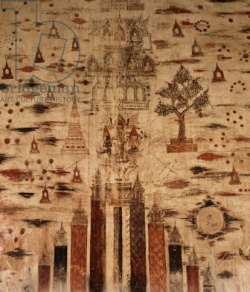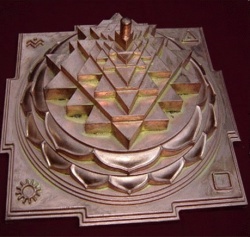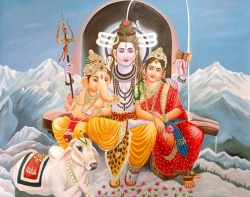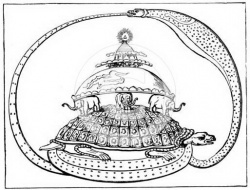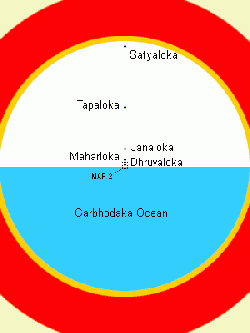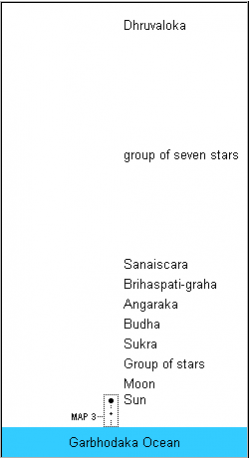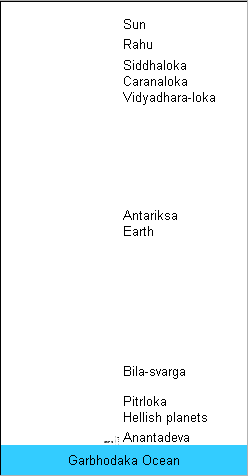Vedic cosmology
Vedic cosmology - planetarium With in and beyond time and space: Tour the transcendental world, the material world and find the way back
This is a simplified way to understand the wanderings of a spirit soul within Samsara, the cycle of birth and death. It shows the basic facts needed to understand this world and the life in it and helps to learn about the different ways of life leading to elevation or degradation. With this information you can be more in control of your life, in harmony with the universe and its laws:
This 'tour' is based on Vedic scriptures like Bhagavad- gita (BG), Bhagavata purana (SB), Brahma-samhita (B-s), as well as others. Gaudiya Vaisnava siddhanta is most elaborately presented in Sad-sandarbhas of Sri Jiva Gosvami.
I am jiva, spirit soul, part and parcel and eternal servant of the Lord. My svarupa, spiritual Body, is similar in form to any of the material bodies in the material world but it is of the same quality as myself and the whole spiritual world (sac-cid-Ananda). Although I could stay here eternally in Lord's loving company and participate in His lila (pastime), I decided to explore the material world thus beginning my journey...
The Lord does not interfere with my free will by preventing me from leaving Him but is unlimitedly happy when I return to Him again:"Having attained me [Sarupa], a friend more dear than life, as if He had not seen me for a long time, taking my hand in His lotus hand, asking me wonderful questions, bringing happiness to all the people of Vraja, and walking as gracefully as an elephant, the handsome Lord entered the village of Vraja." (Brhad- bhagavatamrta 2.6.76, by Sanatana Goswami)"After attaining Me, the great souls, who are yogis in devotion, never return to this temporary world, which is full of miseries, because they have attained the highest perfection." (BG 8.15)
HARI-DHAMA
This is my home, the transcendental world of sac-cid- Ananda nature (eternal, full of knowledge and full of bliss), abode of the Supreme Lord in His unlimited eternal forms. Its five divisions are called Goloka Vrindavana, Navadvipa, Mathura, Dvaraka, Ayodhya, Vaikuntha (also used as the general name of Hari-dhama).
HERE STARTS AND ENDS MY JOURNEY TO THE MATERIAL WORLD
Goloka Vrindavana - "I worship Govinda, the primeval Lord, who resides in His own realm, Goloka, with Radha, who resembles His own spiritual figure and who embodies the ecstatic potency [hladini]. Their companions are Her confidantes, who embody extensions of Her bodily form and who are imbued and permeated with ever-blissful spiritual rasa." (B-s 5.37)
Navadvipa - "In that place [where Sri Caitanya appears] is a wonderful city like an eight-petal lotus flower. In the middle of that lotus- city is a place called Mayapura, and in the middle of Mayapura is a place called Antardvipa. That place is the home of Lord Caitanya, the Supreme Personality of Godhead." (Chandogya Upanisad)
"That original Lord Krsna appeared in Navadvipa as Lord Caitanya, and Balarama appeared with Him as Lord Nityananda." (Caitanya- caritamrta, Adi-lila 5.6)
"In this Age of Kali, people who are endowed with sufficient intelligence will worship the Lord, who is accompanied by His associates, by performance of sankirtana-yajna congregational chanting of the holy names of the Lord]." (SB 11.5.32)
Mathura - "Sri Uddhava said: Thereafter Lord Krsna went to Mathura City with Sri Baladeva, and to please Their parents They dragged Kamsa, the leader of public enemies, down from his throne and killed him, pulling him along the ground with great strength." (SB 3.3.1)
"Since that time, the city of Mathura had been the capital of all the kings of the Yadu dynasty. The city and district of Mathura are very intimately connected with Krsna, for Lord Krsna lives there eternally." (SB 10.1.28)
Dvaraka - "Undoubtedly it is wonderful that Dvaraka has defeated the glories of the heavenly planets and has enhanced the celebrity of the earth. The inhabitants of Dvaraka are always seeing the soul of all living beings Krsna in His loving feature. He glances at them and favors them with sweet smiles." (SB 1.10.27)
Ayodhya - "Lord Ramacandra returned to His abode, to which bhakti-yogis are promoted. This is the place to which all the inhabitants of Ayodhya went after they served the Lord in His manifest pastimes by offering Him obeisances, touching His lotus feet, fully observing Him as a fatherlike King, sitting or lying down with Him like equals, or even just accompanying Him." (SB 9.11.22)
Vaikuntha - "Therefore, O Lord, feeling weary of material life and tormented by its distresses, I now surrender unto You because You are the perfect master. You are the unlimited, all-knowing Supreme Personality of Godhead, whose spiritual abode in Vaikuntha is free from all disturbances. In fact, You are known as Narayana, the true friend of all living beings." (SB 11.7.18)
Creation of the material world:In a corner of the spiritual sky of brahmajyoti a spiritual cloud sometimes appears, and the covered portion is called the mahat-tattva. The Lord then, by His plenary portion as Maha-Visnu, lies down within the water of the mahat-tattva, and the water is called the Causal Ocean (Karana-jala). While Maha-Visnu sleeps within the Causal Ocean, innumerable universes are generated along with His breathing. These universes are floating, and they are scattered all over the Causal Ocean. They stay only during the breathing period of Maha-Visnu. In each and every universal globe, the same Maha-Visnu enters again as Garbhodakasayi Visnu and lies there on the serpentlike Sesa incarnation. From His navel sprouts a lotus stem, and on the lotus, Brahma, the lord of the universe, is born. Brahma creates all forms of living beings of different shapes in terms of different desires within the universe. He also creates the sun, moon and other demigods. (SB 2.5.33)
MAHAVISNU
Lord Mahavisnu rests in the River Viraja, Causal Ocean (Karanodaka) which is the border between transcendental and material realms.
"The Supreme Living Being in His feature as the transcendental purusa incarnation, who is the Lord's plenary expansion, impregnates the material nature of three modes, and thus by the influence of eternal time the living entities appear. Thereafter, influenced by the interactions of eternal time, the supreme sum total of matter called the mahat-tattva became manifested, and in this mahat-tattva the unalloyed goodness, the Supreme Lord, sowed the seeds of universal manifestation out of His own Body." (SB 3.5.26-27)
The destination of sunyavadis (buddhists) is pradhana, the primordial matter, which has a sunya (void) nature. When Mahavisnu breathes out, it is manifested and transforms gradually into the prakriti, matter, the building block of the material world. When He breathes in, it is withdrawn into His Body together with the jivas absorbed in it. By the look of Mahavisnu I am then transferred into the womb of Durga, the material world.
Pradhana - "In the unmanifest stage of material nature, called pradhana, there is no expression of words, no mind and no manifestation of the subtle elements beginning from the mahat, nor are there the modes of goodness, passion and ignorance. There is no life air or intelligence, nor any senses or demigods. There is no definite arrangement of planetary systems, nor are there present the different stages of consciousness - sleep, wakefulness and deep sleep. There is no ether, water, earth, air, fire or sun. The situation is just like that of complete sleep, or of voidness. Indeed, it is indescribable. Authorities in spiritual science explain, however, that since pradhana is the original substance, it is the actual basis of material creation." (SB 12.4.20-21)
MAHESA-DHAMA
Realm of Lord Siva full of Brahman effulgence. It is situated between Hari-dhama and Devi-dhama.This is the destination of the brahmavadis, impersonalistic worshipers of Siva and those who meditate on Brahman. Here I can stay for a long time as Siva's associate or by his mercy reach Hari-dhama. It may also happen that I break the rules of life here and am sent back to material world.
"The demigods observed Lord Siva sitting on the summit of Kailasa Hill with his wife, Bhavani, for the auspicious development of the three worlds. He was being worshiped by great saintly persons desiring liberation. The demigods offered him their obeisances and prayers with great respect." (SB 8.7.20)
DEVI-DHAMA
This material world is the realm of Durga who is the material energy in her personal form.
"The goddess Durga was decorated with flower garlands, smeared with sandalwood pulp and dressed with excellent garments and ornaments made of valuable jewels. Holding in her hands a bow, a trident, arrows, a shield, a sword, a conchshell, a disc and a club, and being praised by celestial beings like Apsaras, Kinnaras, Uragas, Siddhas, Caranas and Gandharvas, who worshiped her with all kinds of presentations, she spoke as follows." (SB 10.4.10-11)
I, jiva, am now just a transcendental sparkle of an atomic size and according to my desire and Karma I take birth in various material bodies one after another (the cycle of birth and death, or Samsara) within this world characterized by all- pervading presence of birth, death, old age and disease (janma-mrtyu-jara-vyadhi). These are symptoms of my conditioned life based on my identification with matter. During my whole stay here I am accompanied by the Lord in His invisible form of Paramatma (Supersoul) in my heart. He lets me act according to my desires and witnesses and approves my actions.
Paramatma - "I am seated in everyone's heart, and from Me come remembrance, knowledge and forgetfulness. By all the Vedas, I am to be known. Indeed, I am the compiler of Vedanta, and I am the knower of the Vedas." (BG 15.15)
MAP 1
All the universes are clustered together up and down, and each and every one of them is separately sevenfold-covered. The watery portion is beyond the sevenfold coverings, and each covering is ten times more expansive than the previous covering. The extent of the cosmic phenomenon is calculated to be diametrically (both ways) four billion miles. Then the coverings of the universe begin. The first stratum of the covering (earth) is calculated to extend eighty million miles, and the subsequent coverings of the universe are respectively of fire, effulgence, air and ether, one after another, each extending ten times further than the previous. Beyond the sky there are subtle coverings, resembling the elementary coverings of the universes. (SB 2.2.28)
1 yojan = 8 miles = 12,8 km
Dhruvaloka, the polestar, is 3,800,000 yojanas above the sun. Above Dhruvaloka by 10,000,000 yojanas is Maharloka, above Maharloka by 20,000,000 yojanas is Janaloka, above Janaloka by 80,000,000 yojanas is Tapoloka, and above Tapoloka by 120,000,000 yojanas is Satyaloka. Thus the distance from the sun to Satyaloka is 233,800,000 yojanas, or 1,870,400,000 miles. The Vaikuntha planets begin 26,200,000 yojanas (209,600,000 miles) above Satyaloka. Thus the Visnu Purana describes that the covering of the universe is 260,000,000 yojanas (2,080,000,000 miles) away from the sun. (SB 5.23.9)
SATYALOKA
My first Body is that of Brahma, the secondary creator of this world. I live on Satyaloka, the topmost dimensional level in this world. If I am a pure devotee of the Lord, at the end of my long life I will return to Hari-dhama together with my associates, great sages. Otherwise I will be born as a great sage on Muniloka.
"Both the Lord and the living entity, being qualitatively spirit soul, have the tendency for peaceful enjoyment, but when the part of the [[Supreme] Personality of Godhead]] unfortunately wants to enjoy independently, without Krsna, he is put into the material world, where he begins his life as Brahma and is gradually degraded to the status of an ant or a worm in stool." (SB 9.24.58p.)"The yogis who become detached from the material world by practice of breathing exercises and control of the mind reach the planet of Brahma, which is far, far away. After giving up their bodies, they enter into the Body of Lord Brahma, and therefore when Brahma is liberated and goes to the Supreme Personality of Godhead, who is the Supreme Brahman, such yogis can also enter into the kingdom of God." (SB 3.32.10)
MUNILOKA
Muniloka is the general name of the abodes of great sages: Tapoloka, Janaloka, Maharloka. These sages constantly meditate on the Lord. Here I'm one of the sages and by my meditation I can go either higher, up to Satyaloka, to become Brahma's associate, or down, to the level of devas (demigods).
"By mystic yoga, great austerities and the renounced order of life, the pure destinations of Maharloka, Janoloka, Tapoloka and Satyaloka are attained. But by devotional yoga, one achieves My transcendental abode." (SB 11.24.14)
MAP 2
The moon is situated 100,000 yojanas above the rays of the sunshine. Day and night on the heavenly planets and Pitrloka are calculated according to its waning and waxing. Above the moon by a distance of 200,000 yojanas are some stars, and above these stars is Sukra-graha (Venus), whose influence is always auspicious for the inhabitants of the entire universe.
AboveSukra-graha by 200,000 yojanas is Budha-graha (Mercury), whose influence is sometimes auspicious and sometimes inauspicious. Next, above Budha-graha by 200,000 yojanas, is Angaraka (Mars), which almost always has an unfavorable influence. Above Angaraka by another 200,000 yojanas is the planet called Brhaspati-graha (Jupiter), which is always very favorable for qualified brahmanas. Above Brhaspati-graha is the planet Sanaiscara (Saturn), which is very inauspicious, and above Saturn is a group of seven stars occupied by great saintly persons who are always thinking of the welfare of the entire universe. These seven stars circumambulate Dhruvaloka, which is the residence of Lord Visnu within this universe. (SB 5.22.8 - 17)
SVARGALOKA
Svargaloka is the abode of demigods. I'm now Indra (the chief demigod) or one of the other demigods and my duty is to manage the affairs of the universe, protecting its inhabitants against the asuras (demons) as an empowered servant of the Lord. If I become advanced in my devotional service, I will be born as a sage in Muniloka. If I become attached to material enjoyment, I will degrade into a lower position becoming a semi- demigod or a human being.
"Men of small knowledge are very much attached to the flowery words of the Vedas, which recommend various fruitive activities for elevation to heavenly planets, resultant good birth, Power, and so forth. Being desirous of sense gratification and opulent life, they say that there is nothing more than this." (BG 2.42-43)
Indra: "We are now living in the heavenly planets, undoubtedly as a result of our having performed ritualistic ceremonies, pious activities and yajnas and having studied the Vedas. However, our lives here will one day be finished. We pray that at that time, if any merit remains from our pious activities, we may again take birth in Bharata-varsa as human beings able to remember the lotus feet of the Lord. The Lord is so kind that He personally comes to the land of Bharata-varsa and expands the good fortune of its people." (SB 5.19.28)
Bhuvarloka - the level of semi- demigods (Carana, Vidyadhara, Kinnara, Kimpurusa etc.). As one of the lesser demigods I am assisting the demigods in various ways and sometimes interacting with the humans. By advancement in my service I can become a demigod or to subdue to the enjoying nature and be born as a human on the earthly level, Bhurloka.
Semi-demigods - "Below Rahu by 10,000 yojanas [80,000 miles] are the planets known as Siddhaloka, Caranaloka and Vidyadhara-loka." (SB 5.24.4)
"While He was passing in the northern direction, all the celestial denizens known as Caranas and Gandharvas, as well as the munis and the damsels of the heavenly planets, prayed and offered Him all respects. The ocean offered Him oblations and a place of residence." (SB 3.33.34)
MAP 3
Rahu is situated 10,000 yojanas below the sun. Below Rahu by another 10,000 yojanas are the planets of the Siddhas, Caranas and Vidyadharas, and below these are planets such as Yaksaloka and Raksaloka. Below these planets is the earth, and 70,000 yojanas below the earth are the lower planetary systems Bila-svarga:
Atala, Vitala, Sutala, Talatala, Mahatala, Rasatala and Patala.
Demons and Raksasas live in these lower planetary systems with their wives and children, always engaged in sense gratification and not fearing their next births. The sunshine does not reach these planets, but they are illuminated by jewels fixed upon the hoods of snakes. Because of these shining gems there is practically no darkness. Those living in these planets do not become old or diseased, and they are not afraid of death from any cause but the time factor, the Supreme Personality of Godhead. In the planet Atala, the yawning of a demon has produced three kinds of women, called svairini (independent), kamini (lusty) and pumscali (very easily subdued by men). Below Atala is the planet Vitala, wherein Lord Siva and his wife Gauri reside.
Because of their presence, a kind of gold is produced called hataka. Below Vitala is the planet Sutala, the abode of Bali Maharaja, the most fortunate king. Bali Maharaja was favored by the Supreme personality of Godhead, Vamanadeva, because of his intense devotional service. Below Sutala is the planet Talatala, the abode of the demon Maya. This demon is always materially happy because he is favored by Lord Siva, but he cannot achieve spiritual happiness at any time. Below Talatala is the planet Mahatala, where there are many snakes with hundreds and thousands of hoods.
Below Mahatala is Rasatala, and below that is Patala (Nagaloka), where the serpent Vasuki lives with his associates. (SB 5.24.1 - 31) The hellish planets are situated in the intermediate space between the three worlds and the Garbhodaka Ocean. They lie on the southern side of the universe, beneath Bhu-mandala, and slightly above the water of the Garbhodaka Ocean. Pitrloka is also located in this region between the Garbhodaka Ocean and the lower planetary systems. All the residents of Pitrloka, headed by Agnisvatta, meditate in great Samadhi on the [[Supreme] Personality of Godhead]] and always wish their families well. (SB 5.26.5) Approximately 240,000 miles beneath the planet Patala lives Lord Ananta. This great universe, situated on one of Lord Anantadeva's thousands of hoods, appears just like a white mustard seed. (SB 5.25.1 - 2) The distance from the sun to the earth is lower planetary systems called Atala, Vitala, Sutala, Talatala, Mahatala, Rasatala and Patala. Below these lower planets by 30,000 yojanas, Sesa Naga is lying on the Garbhodaka Ocean. That ocean is 249,800,000 yojanas deep. Thus the total diameter of the universe is approximately 500,000,000 yojanas, or 4,000,000,000 miles. (SB 5.23.9)
ANTARIKSA
Between Bhuvarloka and Bhurloka is antariksa, an interplanetary space where the Sun is situated. Here live beings like Raksasas, Yaksas, Pisacas and ghosts. They often descend on earth and are generally inimical to humans. Usuallly they will be born later as humans.
Ghosts - "Living entities who are associates of Rudra develop in the third mode of material nature, or ignorance. They are situated in the sky between the earthly planets and the heavenly planets." (SB 3.6.29)
"Beneath Vidyadhara-loka, Caranaloka and Siddhaloka, in the sky called antariksa, are the places of enjoyment for the Yaksas, Raksasas, Pisacas, ghosts and so on. Antariksa extends as far as the wind blows and the clouds float in the sky. Above this there is no more air." (SB 5.24.5)
LORD ANANTA
Approximately 240,000 miles beneath the planet Patala lives another incarnation of the Supreme Personality of Godhead. He is the expansion of Lord Visnu known as Lord Ananta or Lord Sankarsana. He is always in the transcendental position, but because He is worshiped by Lord Siva, the deity of tamo-guna or darkness, He is sometimes called tamasi. Lord Ananta is the predominating Deity of the material mode of ignorance as well as the false ego of all conditioned souls. When a conditioned living being thinks, "I am the enjoyer, and this world is meant to be enjoyed by me," this conception of life is dictated to him by Sankarsana. Thus the mundane conditioned soul thinks himself the Supreme Lord. This great universe, situated on one of Lord Anantadeva's thousands of hoods, appears just like a white mustard seed. It is infinitesimal compared to the hood of Lord Ananta. At the time of devastation, when Lord Anantadeva desires to destroy the entire creation, He becomes slightly angry. Then from between His two eyebrows appears three-eyed Rudra, carrying a trident. (SB 5.25.1 - 3)
